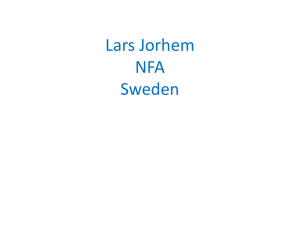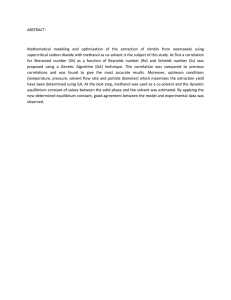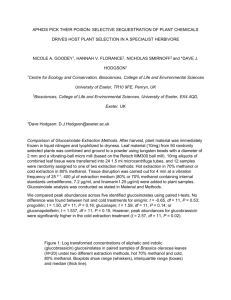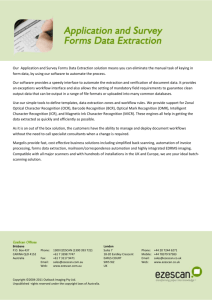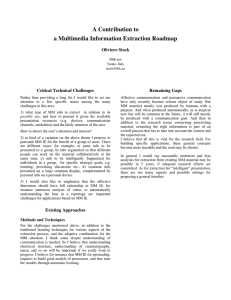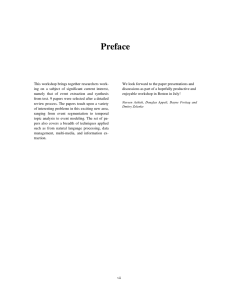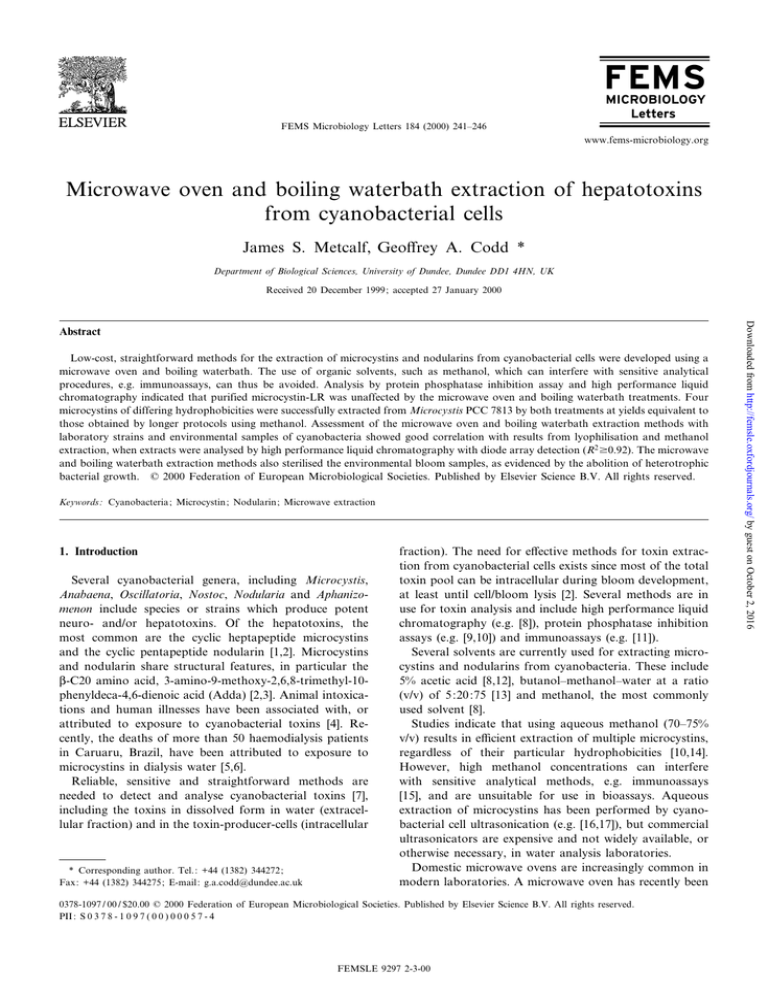
FEMS Microbiology Letters 184 (2000) 241^246
www.fems-microbiology.org
Microwave oven and boiling waterbath extraction of hepatotoxins
from cyanobacterial cells
James S. Metcalf, Geo¡rey A. Codd *
Department of Biological Sciences, University of Dundee, Dundee DD1 4HN, UK
Received 20 December 1999; accepted 27 January 2000
Low-cost, straightforward methods for the extraction of microcystins and nodularins from cyanobacterial cells were developed using a
microwave oven and boiling waterbath. The use of organic solvents, such as methanol, which can interfere with sensitive analytical
procedures, e.g. immunoassays, can thus be avoided. Analysis by protein phosphatase inhibition assay and high performance liquid
chromatography indicated that purified microcystin-LR was unaffected by the microwave oven and boiling waterbath treatments. Four
microcystins of differing hydrophobicities were successfully extracted from Microcystis PCC 7813 by both treatments at yields equivalent to
those obtained by longer protocols using methanol. Assessment of the microwave oven and boiling waterbath extraction methods with
laboratory strains and environmental samples of cyanobacteria showed good correlation with results from lyophilisation and methanol
extraction, when extracts were analysed by high performance liquid chromatography with diode array detection (R2 v0.92). The microwave
and boiling waterbath extraction methods also sterilised the environmental bloom samples, as evidenced by the abolition of heterotrophic
bacterial growth. ß 2000 Federation of European Microbiological Societies. Published by Elsevier Science B.V. All rights reserved.
Keywords : Cyanobacteria; Microcystin ; Nodularin; Microwave extraction
1. Introduction
Several cyanobacterial genera, including Microcystis,
Anabaena, Oscillatoria, Nostoc, Nodularia and Aphanizomenon include species or strains which produce potent
neuro- and/or hepatotoxins. Of the hepatotoxins, the
most common are the cyclic heptapeptide microcystins
and the cyclic pentapeptide nodularin [1,2]. Microcystins
and nodularin share structural features, in particular the
L-C20 amino acid, 3-amino-9-methoxy-2,6,8-trimethyl-10phenyldeca-4,6-dienoic acid (Adda) [2,3]. Animal intoxications and human illnesses have been associated with, or
attributed to exposure to cyanobacterial toxins [4]. Recently, the deaths of more than 50 haemodialysis patients
in Caruaru, Brazil, have been attributed to exposure to
microcystins in dialysis water [5,6].
Reliable, sensitive and straightforward methods are
needed to detect and analyse cyanobacterial toxins [7],
including the toxins in dissolved form in water (extracellular fraction) and in the toxin-producer-cells (intracellular
* Corresponding author. Tel. : +44 (1382) 344272;
Fax: +44 (1382) 344275; E-mail : g.a.codd@dundee.ac.uk
fraction). The need for e¡ective methods for toxin extraction from cyanobacterial cells exists since most of the total
toxin pool can be intracellular during bloom development,
at least until cell/bloom lysis [2]. Several methods are in
use for toxin analysis and include high performance liquid
chromatography (e.g. [8]), protein phosphatase inhibition
assays (e.g. [9,10]) and immunoassays (e.g. [11]).
Several solvents are currently used for extracting microcystins and nodularins from cyanobacteria. These include
5% acetic acid [8,12], butanol^methanol^water at a ratio
(v/v) of 5:20:75 [13] and methanol, the most commonly
used solvent [8].
Studies indicate that using aqueous methanol (70^75%
v/v) results in e¤cient extraction of multiple microcystins,
regardless of their particular hydrophobicities [10,14].
However, high methanol concentrations can interfere
with sensitive analytical methods, e.g. immunoassays
[15], and are unsuitable for use in bioassays. Aqueous
extraction of microcystins has been performed by cyanobacterial cell ultrasonication (e.g. [16,17]), but commercial
ultrasonicators are expensive and not widely available, or
otherwise necessary, in water analysis laboratories.
Domestic microwave ovens are increasingly common in
modern laboratories. A microwave oven has recently been
0378-1097 / 00 / $20.00 ß 2000 Federation of European Microbiological Societies. Published by Elsevier Science B.V. All rights reserved.
PII: S 0 3 7 8 - 1 0 9 7 ( 0 0 ) 0 0 0 5 7 - 4
FEMSLE 9297 2-3-00
Downloaded from http://femsle.oxfordjournals.org/ by guest on October 2, 2016
Abstract
242
J.S. Metcalf, G.A. Codd / FEMS Microbiology Letters 184 (2000) 241^246
used for the acid hydrolysis of microcystins -LR, -YR,
-RR, -LA and nodularin to their constituent amino acids
[18]. Furthermore, microwave extraction has been applied
to several other compounds including £avin mononucleotides [19], herbicides [20] and amino acids [21]. Microwave
extraction has also been applied to complex matrices including soil, sediments and animal tissue [22,23]. The purpose of the present study was to develop low-cost, facile
and rapid extraction methods for microcystins and nodularins from laboratory cultures and environmental samples
of cyanobacteria.
2. Materials and methods
Cultures of Microcystis PCC 7813 were maintained and
grown as before [10]. Intracellular microcystin concentrations were determined after : (1) lyophilisation and extraction with 70% (v/v) methanol [10] and (2) resuspension of
fresh cells from liquid culture in 150 Wl of Milli-Q water,
followed by 1 min of ultrasonication (MSE Soniprep 150,
5 mm diameter probe, full power). Samples were centrifuged (6 min, 14 000Ug Eppendorf centrifuge 5415) and
supernatants analysed by high performance liquid chromatography with diode array detection (HPLC-DAD) [8].
These two extraction methods were used as references
for the development of new extraction methods for the
toxins. Further samples of Microcystis PCC 7813 were
subjected to microwave or boiling waterbath incubation
and were then analysed.
For microwave and boiling waterbath extraction, 1.5 ml
of Microcystis PCC7813 cell suspension was centrifuged in
an Eppendorf tube as before, resuspended with 150 Wl
Milli-Q water and the Eppendorf cap was closed. Microwave extractions were performed using a Proline1 M
2020-A (650 W) microwave oven at full power and boiling
waterbath extractions were performed at STP. All extractions were performed for periods between 0 and 9 min.
Samples were removed, cooled on ice and centrifuged at
14 000Ug for 6 min before analysis of the supernatants by
HPLC-DAD [8].
2.2. E¡ect of extraction procedure on the structure and
toxicity of microcystin-LR according to HPLC-DAD
and protein phosphatase inhibition assay
Microcystin-LR, puri¢ed to s 97% purity [8] was dissolved in a minimal volume of 100% methanol and diluted
with Milli-Q water. These samples were ultrasonicated for
1 min at full power, or placed in Eppendorf centrifuge
tubes, which were sealed and placed in a boiling waterbath
for 1 min, or incubated in the microwave oven at full
power for 9 min. All samples were then cooled on ice
2.3. Boiling waterbath and microwave extraction of
microcystins and nodularins from laboratory strains
and environmental samples of cyanobacteria
Cyanobacterial strains were maintained and grown as
described previously [10] except DUN902, DUN903,
DUN904 and BY1 for which media contained 25% (v/v)
seawater. Toxin extraction by boiling waterbath and microwave oven incubation was performed as in Section 2.1
and supernatants analysed by HPLC-DAD [8]. Comparison was made with extracts prepared from lyophilised
material, using 70% (v/v) aqueous methanol [10].
2.4. E¡ects of boiling waterbath and microwave oven
extraction protocols for hepatotoxin extraction on the
viability of associated bacteria in environmental
samples
The ability of the boiling waterbath and microwave
oven treatments to sterilise environmental samples was
examined by determining bacterial colony formation
under aerobic conditions using bloom material from Baf¢ns Pond, England (06/08/1997) which received microwave
treatment and from Combwich Pond, England (11/07/
1998) which underwent boiling waterbath treatment. Aliquots of supernatant (50 Wl) were spread-plated onto nutrient agar and incubated aerobically at 25³C in the dark
for up to 9 days. Plates were inspected regularly and the
number of visible bacterial colonies recorded.
Fig. 1. Method development for boiling waterbath and microwave procedures for the extraction of microcystin-LR from Microcystis PCC
7813 cells, compared with the standard methods of ultrasonication and
lyophilisation followed by methanol extraction. Samples of Microcystis
PCC 7813 were centrifuged, resuspended in 150 Wl of Milli-Q water and
subjected to: lyophilisation and methanol extraction (R); ultrasonication (F); boiling waterbath treatment (S); microwave treatment (b).
Samples were analysed by HPLC-DAD. Points are the mean of two determinations and vertical error bars represent the range between the individual observations.
FEMSLE 9297 2-3-00
Downloaded from http://femsle.oxfordjournals.org/ by guest on October 2, 2016
2.1. Method development and microcystin extraction from
Microcystis PCC 7813
and centrifuged at 14 000Ug for 6 min. Analysis of the
supernatants was performed by HPLC-DAD and a protein phosphatase inhibition assay [10] in comparison with
untreated controls.
J.S. Metcalf, G.A. Codd / FEMS Microbiology Letters 184 (2000) 241^246
243
3. Results
Fig. 2. E¡ect of: (A) ultrasonication; (B) boiling waterbath treatment
and (C) microwave treatment on puri¢ed microcystin-LR in aqueous solution as determined by protein phosphatase inhibition assay. Microcystin-LR (0.1 to 500 nM (B) and 0.1 to 1000 nM (A, C)) was subjected
to 1 min ultrasonication (A), 1 min in a boiling waterbath (B) or 9 min
of microwave treatment (C). Treated (F) and untreated (b) samples (10
Wl) were removed and assayed as described [10]. Points are the means of
three determinations and vertical error bars represent standard deviation.
used to compare microcystin-LR equivalents, determined
by HPLC-DAD, for the extraction methods performed on
the laboratory strains and environmental samples. All correlations were signi¢cant (R2 v0.92), although there was a
slight underestimation of microcystin-LR equivalents by
Table 1
Concentrations of the four most abundant microcystin variants from Microcystis PCC 7813 after extraction by ultrasonication, lyophilisation followed
by methanol extraction, boiling waterbath treatment and microwave treatment
Microcystin variant
Ultrasonication
Methanol extraction
Boiling waterbath extraction
Microwave extraction
-LR
-LY
-LW
-LF
Total
0.460
0.052
0.120
0.106
0.738
0.392
0.051
0.116
0.111
0.670
0.401
0.044
0.092
0.087
0.624
0.440
0.051
0.118
0.111
0.720
(0.001)
(0.001)
(0.001)
(0.003)
(0.050)
(0.004)
(0.009)
(0.004)
(0.017)
(0.002)
(0.006)
(0.006)
(0.009)
(0.002)
(0.004)
(0.004)
Values are expressed as Wg of toxin (microcystin-LR equivalents) per mg dry weight of cells. Figures in parentheses represent standard deviation (n = 3).
FEMSLE 9297 2-3-00
Downloaded from http://femsle.oxfordjournals.org/ by guest on October 2, 2016
The use of the boiling waterbath and microwave treatments resulted in the extraction of microcystin-LR into the
extracellular fraction (Fig. 1). In comparison with cell lyophilisation and the subsequent extraction of microcystin(s)
using methanol, the microwave and boiling waterbath
treatments permitted maximum detection of microcystins
(2 Wg microcystin-LR ml31 ) after 9 and 1 min, respectively
in the extracts. Only extracts obtained by ultrasonication
of Microcystis cells failed to contain this toxin concentration, reaching a maximum of 1.5 Wg ml31 . The e¡ects of
the microwave and boiling waterbath procedures were assessed for the extraction of the four most abundant microcystins from Microcystis PCC 7813 (Table 1). All four
toxins were extracted, although there were slight di¡erences in microcystin concentrations which were not signi¢cant (R2 v0.997, ANOVA). The sum of the microcystin
concentrations detected when Microcystis PCC 7813 cells
underwent ultrasonication, microwave treatment, lyophilisation with subsequent methanol extraction and boiling
waterbath extraction were 0.738, 0.720, 0.670 and 0.624
Wg microcystin-LR equivalents ml31 , respectively.
The extraction methods were investigated for their e¡ect
on the structure and toxicity of puri¢ed microcystin-LR
according to HPLC-DAD and protein phosphatase inhibition assays (Fig. 2). Exposure of puri¢ed microcystinLR solutions at 23.5 Wg ml31 to microwaves for up to
9 min, or to boiling waterbath incubation and to ultrasonication for up to 1 min each, revealed no di¡erences in the
retention time (16.3 min), shape or area (0.0005 AUUmin)
of the toxin peak by HPLC-DAD compared with untreated controls. Assessment of puri¢ed microcystin-LR
samples by colorimetric protein phosphatase inhibition assay (Fig. 2) indicated that no alteration of the microcystinLR toxicity had occurred.
These methods were extended to microcystin- or nodularin-containing laboratory strains and environmental
samples of cyanobacteria (Table 2). Both methods were
found to extract the toxins from cultures of Microcystis,
Nodularia, Nostoc and Planktothrix. Microwave treatment
of two Microcystis blooms and one of Anabaena yielded
similar concentrations of microcystins compared to methanol extraction (Table 2). Linear regression analysis was
244
J.S. Metcalf, G.A. Codd / FEMS Microbiology Letters 184 (2000) 241^246
Fig. 3. Sterilisation of cyanobacterial blooms, as indicated by the abolition of subsequent bacterial colony development, by (A) microwave;
and (B) boiling waterbath treatment (n = 2). Microcystis spp. bloom
samples (06/08/97) were subjected to microwave treatment (A) for 0 (F),
3 (b), 6 (R) or 9 min (S). Aphanizomenon spp. bloom samples (11/07/
98) were incubated in a boiling waterbath (B) for 0 (F), 15 (R), 30
(S), 45 (b) and 60 s (8). Samples (50 Wl) were removed and spreadplated onto nutrient agar and bacterial colonies counted during aerobic
incubation at 25³C in the dark. Vertical error bars represent the range
of individual values obtained in the observations.
4. Discussion
The increasing use of sensitive methods to detect microcystins and nodularins, such as immunoassays and bioassays, can require precautions to ensure that concentrations
of organic solvents such as methanol do not interfere with
the assays. Using an ELISA kit for microcystins, methanol
concentrations should not exceed 5% (v/v) to avoid the
production of false positives [15]. For the immunoassay
Table 2
Comparison of boiling waterbath, microwave and methanol treatments for microcystin and nodularin extraction from cyanobacterial strains and
blooms
Cyanobacterial genus
Strain
Boiling waterbath treatment
Microwave treatment
Methanol treatment
Microcystis
Microcystis
Microcystis
Microcystis
Planktothrix
Nostoc
Nodularia
Nodularia
Nodularia
Nodularia
Nodularia
Nodularia
RID II
RID I
DUN881
PCC7820
NIES 595
DUN 901
DUN902
DUN904
BY1
PCC7804
OO1E
DUN903
1.020
1.306
3.655
3.824
0.650
0.220
0.031
0.082
0.031
5.130
N/T
N/T
1.043
1.348
2.967
3.200
0.301
0.221
0.030
0.073
0.016
5.860
0.071
0.097
1.240
1.265
3.277
5.007
0.655
0.189
0.029
0.109
0.029
4.400
0.141
0.095
N/T
N/T
N/T
0.169
0.104
0.228
0.170
0.115
0.283
Predominant cyanobacterial genus
Blooms and collection date
Microcystis
Microcystis
Anabaena
Loch Fad, 14/07/97
Ba¤ns Pond, 06/08/97
Glenfarg, 14/08/97
Mean concentrations of toxins were determined by HPLC-DAD (n = 2).
N/T, not tested.
Valves are given as MC-LR equivalents (Wg mg31 dry weight); toxin concentration estimated as equivalents of microcystin-LR (by reference to a calibration graph constructed with the variant) per mg dry wt of sample taken for toxin extraction.
FEMSLE 9297 2-3-00
Downloaded from http://femsle.oxfordjournals.org/ by guest on October 2, 2016
lyophilisation with methanol extraction, compared with
both microwave and boiling waterbath extraction, as indicated by the gradient of the linear regression line (0.91,
microwave versus methanol; 0.97, boiling waterbath versus methanol; 1.00, boiling waterbath versus microwave).
The ability of the microwave and boiling waterbath protocols to sterilise environmental samples was assessed by
investigating their e¡ects on bacterial viability (Fig. 3).
Microwave treatment reduced the number of bacterial colonies which developed on nutrient agar, which decreased
with increasing microwave application time. Microwave
treatment for 6 min was su¤cient to completely prevent
bacterial colony growth under the conditions used (Fig.
3A). Similarly, boiling waterbath treatment inhibited bacterial colony growth, although shorter application times
were su¤cient for complete inhibition (Fig. 3B). However,
the extraction methods developed include the centrifugation of environmental bloom material. As post-treatment
bacterial colony growth was investigated in the supernatant, the presence of bacteria within the cell pellet cannot
be discounted.
J.S. Metcalf, G.A. Codd / FEMS Microbiology Letters 184 (2000) 241^246
Acknowledgements
We thank the UK Natural Environment Research
Council and the European Commission (CYANOTOX
Project ENV4-CT98-0802) for supporting this work and
Kenneth Beattie for useful discussions.
References
[1] Carmichael, W.W. (1997) The cyanotoxins. Adv. Bot. Res. inc. Adv.
Plant Pathol. 27, 211^256.
[2] Codd, G.A., Bell, S.G., Kaya, K., Ward, C.J., Beattie, K.A. and
Metcalf, J.S. (1999) Cyanobacterial toxins, exposure routes and human health. Eur. J. Phycol. 34, 405^415.
[3] Bell, S.G. and Codd, G.A. (1994) Cyanobacterial toxins and human
health. Rev. Med. Microbiol. 5, 256^264.
[4] Codd, G.A. (1995) Cyanobacterial toxins: occurrence, properties and
signi¢cance. Water Sci. Technol. 32, 149^156.
[5] Jochimsen, E.M., Carmichael, W.W., An, J.S., Cardo, D.M., Cookson, S.T., Holmes, C.E.M., Antunes, M.B.D, de Melo, D.A., Lyra,
T.M., Barreto, V.S.T., Azevedo, S.M.F.O. and Jarvis, W.R. (1998)
Liver failure and death after exposure to microcystins at a hemodialysis center in Brazil. New Engl. J. Med. 338, 873^878.
[6] Pouria, S., de Andrade, A., Barbosa, J., Cavalcanti, R.L., Barreto,
V.S.T., Ward, C.J., Preiser, W., Poon, G.K., Neild, G.H. and Codd,
G.A. (1998) Fatal microcystin intoxication in haemodialysis unit in
Caruaru, Brazil. Lancet 352, 21^26.
[7] Bell, S.G. and Codd, G.A. (1996) Detection, analysis and risk assessment of cyanobacterial toxins. In: Agricultural Chemicals and the
Environment, Issues in Environmental Science and Technology (Hester, R.E. and Harrison, R.M., Eds.), Vol. 5, pp. 109^122. Royal
Society of Chemistry, Cambridge.
[8] Lawton, L.A., Edwards, C. and Codd, G.A. (1994) Extraction and
high-performance liquid chromatographic method for the determination of microcystins in raw and treated waters. Analyst 119, 1525^
1530.
[9] An, J. and Carmichael, W.W. (1994) Use of a colorimetric protein
phosphatase assay and enzyme linked immunoassay for the study of
microcystins and nodularin. Toxicon 12, 1495^1507.
[10] Ward, C.J., Beattie, K.A., Lee, E.Y.C. and Codd, G.A. (1997) Colorimetric protein phosphatase inhibition assay of laboratory strains
and natural blooms of cyanobacteria: comparisons with high-performance liquid chromatographic analysis for microcystins. FEMS
Microbiol. Lett. 153, 465^473.
[11] Chu, F.S., Huang, X., Wei, R.D. and Carmichael, W.W. (1989) Production and characterisation of antibodies against microcystins.
Appl. Environ. Microbiol. 55, 1928^1933.
[12] Harada, K-.I., Suzuki, M., Dahlem, A.M., Beasley, V.R., Carmichael, W.W. and Rinehart, K.L. (1988) Improved method for puri¢cation of toxic peptides produced by cyanobacteria. Toxicon 26, 433^
439.
[13] Krishnamurthy, T., Carmichael, W.W. and Sarver, E.W. (1986)
Toxic peptides from freshwater cyanobacteria (blue-green algae) 1.
Isolation, puri¢cation and characterisation of peptides from Microcystis aeruginosa and Anabaena £os-aquae. Toxicon 24, 865^873.
[14] Fastner, J., Flieger, I. and Neuman, U. (1998) Optimised extraction
of microcystins from ¢eld samples: a comparison of di¡erent solvents
and procedures. Water Res. 32, 3177^3181.
[15] Beattie, K.A., Raggett, S.L. and Codd, G.A. (1998) Applications and
performance assessment of a commercially-available ELISA kit for
microcystins. In: Abstracts of the Fourth International Toxic Cyanobacteria Symposium, 27 Sept.^1 Oct. 1998, Beaufort, NC, p. 40.
[16] Jones, G.J., Blackburn, S.I. and Parker, N.S. (1994) A toxic bloom of
Nodularia spumigena Mertens in Orielton Lagoon, Tasmania. Aust. J.
Mar. Freshwater Res. 45, 787^800.
[17] Bolch, C.J.S., Orr, P.T., Jones, G.J. and Blackburn, S.I. (1999) Genetic, morphological and toxicological variation among globally distributed strains of Nodularia (Cyanobacteria). J. Phycol. 35, 339^355.
[18] Reichelt, M., Hummert, C. and Luckas, B. (1999) Hydrolysis of
microcystins and nodularin by microwave radiation. Chromatographia 49, 671^677.
[19] Greenway, G.M. and Kometa, N. (1994) Online sample preparation
for the determination of ribo£avin and £avin mononucleotides in
foodstu¡s. Analyst 119, 929^935.
[20] Stout, S.J., daCunha, A.R. and Allardice, D.G. (1996) Microwaveassisted extraction coupled with gas chromatography electron capture
negative chemical ionization mass spectrometry for the simpli¢ed
determination of imidazolinone herbicides in soil at the ppb level.
Anal. Chem. 68, 653^658.
[21] Kovacs, A., Ganzler, K. and SimonSarkadi, L. (1998) Microwaveassisted extraction of free amino acids from foods. Z. Lebensm.unters. -forsch. A 207, 26^30.
[22] Lopezavila, V., Young, R. and Beckert, W.F. (1994) Microwave-assisted extraction of organic-compounds from standard reference soils
and sediments. Anal. Chem. 66, 1097^1106.
[23] Akhtar, M.H., Wong, M.L., Crooks, S.R.H. and Sauve, A. (1998)
Extraction of incurred sulfamethazine in swine tissue by microwave
assisted extraction and quanti¢cation without clean up by high performance liquid chromatography following derivatization with dimethylaminobenzaldehyde. Food Addit. Contam. 15, 542^549.
FEMSLE 9297 2-3-00
Downloaded from http://femsle.oxfordjournals.org/ by guest on October 2, 2016
of these toxins from cyanobacterial cells and other matrices, extraction methods should preferably avoid these organic solvents, but should still be low-cost and straightforward. The use of a microwave oven or a boiling waterbath
ful¢lled these requirements. These methods were successfully employed to extract microcystins and nodularins
from laboratory strains and natural blooms of cyanobacteria and were as e¡ective as the established methanol
extraction protocol. Microwave oven and boiling waterbath treatments of aqueous suspensions of cyanobacterial
cells can therefore remove the need for methanol and to
dilute methanol extracts before immunoassay or bioassay,
to avoid interference by methanol.
Aquatic bacteria have been shown to degrade microcystins [24^27]. The microwave oven and boiling waterbath
treatments abolished subsequent heterotrophic bacterial
growth in bloom samples (Fig. 3), indicating that these
treatments, with optimisation, may be used as single-step
aqueous extraction and sterilisation methods for cyanobacterial hepatotoxins. If precautions are taken to avoid
post-extraction microbial contamination, these methods
may be useful if conditions are required to preclude
post-extraction microbial degradation of the toxins.
Finally, with the increasing use of immunoassays to
analyse cyanobacterial hepatotoxins and the prospect
that these can be used in the ¢eld, the need for simple,
rapid on-site extraction methods is increased. A boiling
waterbath at the ¢eld site, requiring nothing more advanced than a camping stove, may therefore o¡er the possibility to rapidly extract microcystins and nodularins for
on-site analysis, without the need for organic solvents with
their potential for interference in immunoassays.
245
246
J.S. Metcalf, G.A. Codd / FEMS Microbiology Letters 184 (2000) 241^246
[24] Jones, G.J., Bourne, D.G., Blakely, R.L. and Doelle, H. (1994) Degradation of the cyanobacterial hepatotoxin microcystin-LR by
aquatic bacteria. Nat. Toxins 2, 228^235.
[25] Codd, G.A. and Bell, S.G. (1996) The occurrence and fate of bluegreen algal toxins in freshwaters. National Rivers Authority RpD
Report No. 29, p. 30. Her Majesty's Stationary O¤ce, London.
[26] Cousins, I.T., Bealing, D.J., James, H.A. and Sutton, A. (1996) Bio-
degradation of microcystin-LR by indigenous mixed bacterial populations. Water Res. 30, 481^485.
[27] Bourne, D.G., Jones, G.J., Blakely, R.L., Jones, A., Negri, A.P. and
Riddles, P. (1996) Enzymatic pathway for the bacterial degradation
of the cyanobacterial cyclic peptide toxin microcystin-LR. Appl. Env.
Microbiol. 62, 4086^4094.
Downloaded from http://femsle.oxfordjournals.org/ by guest on October 2, 2016
FEMSLE 9297 2-3-00

